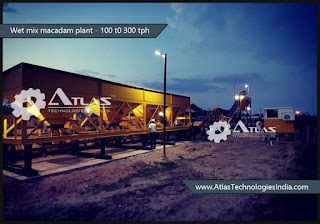Wet mixing facilities have several uses in the construction sector
Wet mix plants, also referred to as wet batch plants or wet mix concrete plants, are specifically designed for producing high-quality concrete. They are commonly used in construction projects where consistent and uniform concrete is required.
The process of a wet mix plant involves the precise mixing of aggregates (such as sand, gravel, or crushed stone), cement, water, and additives. The aggregates and cement are combined in predetermined proportions in a mixer. Water is added gradually to achieve the desired consistency, and additives can be introduced to enhance certain properties of the concrete, such as strength, workability, or durability.
One of the key advantages of wet mix plants is that they ensure thorough mixing of all the components, resulting in a homogeneous mixture. The mixing process in a wet batch plant is typically carried out in a twin-shaft or planetary mixer, which helps to achieve a consistent and uniform distribution of materials.
Wet mix plants offer several benefits, including:
Consistent quality: The thorough mixing process ensures a uniform distribution of aggregates, cement, and additives, leading to consistent and high-quality concrete.
Better workability: Wet mix concrete has good workability, making it easier to place, compact, and finish.
Reduced dust and noise: Wet mix plants typically have enclosed mixing systems, which help to minimize the release of dust and reduce noise levels compared to dry mix plants.
Flexibility: Wet mix plants can handle a wide range of concrete mix designs and can be adjusted to meet specific project requirements.
Faster production: With a continuous mixing process, wet mix plants can produce concrete at a faster rate compared to manual or on-site mixing methods.
Overall, wet mix plants are widely used in various construction applications, including buildings, roads, bridges, dams, and other infrastructure projects, where high-quality and consistent concrete is essential.
Here are some additional details about wet mix plants:
Components of a wet mix plant: A typical wet mix plant consists of several components, including aggregate bins or hoppers for storing and dispensing aggregates, a conveyor system for transferring aggregates to the mixer, a cement silo for storing cement, a water weighing system for accurate measurement of water, a mixer (such as a twin-shaft or planetary mixer) for thorough mixing, and a control system for monitoring and controlling the entire process.
Advantages of wet mix plants:
High-quality concrete: Wet mix plants ensure thorough mixing, resulting in high-quality concrete with uniform strength and consistency.
Accurate control: Wet mix plants have precise control systems that allow for accurate measurement of ingredients, ensuring the desired mix proportions are maintained.
Better workability: Wet mix concrete has good workability, making it easier to handle, place, and finish.
Reduced material waste: The precise control and thorough mixing in wet mix plants help minimize material waste, leading to cost savings.
Suitable for large projects: Wet mix plants are well-suited for large-scale construction projects where a significant volume of concrete is required.
Maintenance and operation: Proper maintenance and regular inspection are important for the efficient operation of wet mix plants. Routine maintenance tasks include cleaning the mixer, checking and lubricating moving parts, inspecting and replacing worn-out components, and ensuring proper calibration of weighing systems. Adequate operator training is also crucial to ensure safe and efficient operation of the plant.
Environmental considerations: Wet mix plants typically have enclosed mixing systems, which help contain dust and minimize the release of particulate matter into the environment. Some wet mix plants also incorporate water recycling systems, allowing for the reuse of process water and reducing water consumption.
Customization options: Wet mix plants can be customized to meet specific project requirements. They can be designed for stationary operation or as mobile units for easy transportation and setup at different job sites. Various optional features and accessories, such as admixture dispensers, moisture probes, and computerized control systems, can be added to enhance the functionality and efficiency of the plant.
It's worth noting that technological advancements and innovations continually shape the wet mix plant industry. Newer models may incorporate advanced automation, improved energy efficiency, and enhanced control systems to optimize performance and productivity.




Comments
Post a Comment